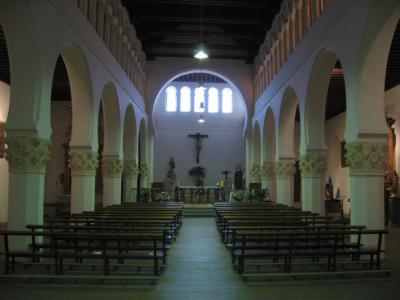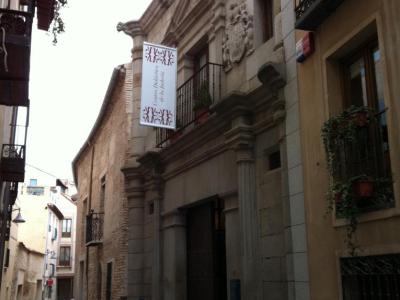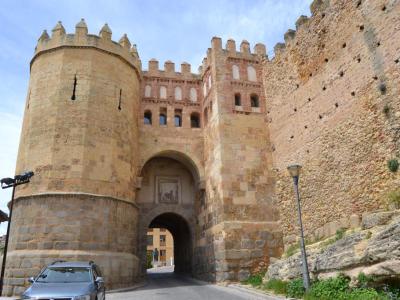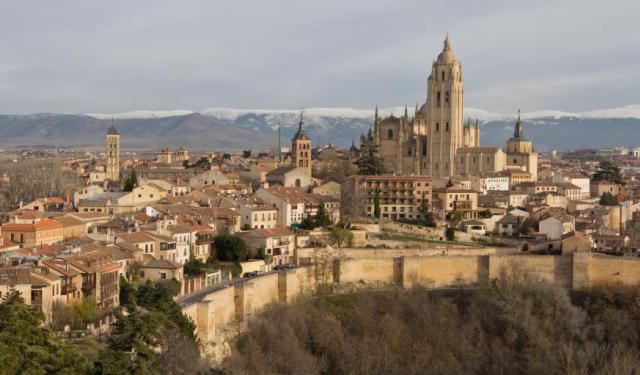
Jewish Quarter Walking Tour (Self Guided), Segovia
For centuries, an exquisite blend of medieval allure and cultural significance has beckoned visitors to Segovia's Jewish Quarter. The undulated shape and seven gates of this storied area set it apart from the rest of the city.
Beyond the boundaries of the Quarter, the majestic Gate of Saint Andrew (Puerta de San Andrés) serves as one of the access points to both the walled city of Segovia and its Jewish Quarter. The timeworn stones of this gate stand as a sentinel of history, inviting passers-by to traverse its threshold and immerse in the enchanting embrace of the area.
Strolling along the Quarter's main cobblestone artery (Calle Judería Vieja), hold your breath and you will feel as if time whispers ancient secrets into your ears while the echoes of a vibrant past reverberate through the atmospheric alleyways.
Despite the passing of centuries since the expulsion of the Jews from Spain in 1492, the spirit of Sephardic heritage is still palpable in the Old Main Synagogue (Antigua Sinagoga Mayor). This resplendent architectural gem is now home to the Church of the Body of Christ (Iglesia de Corpus Christi).
The sanctuary of memory unveils a captivating narrative through the Jewish Quarter Educational Centre. Located in the former Home of Abraham Seneor (Casa de Abraham Seneor), an illustrious descendant of converted Jews, it provides visitors with a deeper understanding of the Jewish history of the city.
As the sun sets, venture beyond the confines of the Quarter and find solace in the contemplative serenity of the Jewish Cemetery (Cementerio Judío). This sacred resting place preserves the eternal bonds of Segovia's Jewish community, a testament to its enduring presence in the city.
Segovia’s Jewish history is what might be best termed as ‘hidden’. Those keen to discover the fusion of cultures that defined Segovia's vibrant past can indulge their senses in the resplendent grandeur of the Segovian Jewish Quarter. Our self-guided tour of this hallowed enclave invites you to unravel the mysteries of time and bear witness to the indelible imprint of a bygone era, where every stone bears memories of resilience, cultural exchange, and a cherished heritage that illuminates the essence of Segovia itself.
Beyond the boundaries of the Quarter, the majestic Gate of Saint Andrew (Puerta de San Andrés) serves as one of the access points to both the walled city of Segovia and its Jewish Quarter. The timeworn stones of this gate stand as a sentinel of history, inviting passers-by to traverse its threshold and immerse in the enchanting embrace of the area.
Strolling along the Quarter's main cobblestone artery (Calle Judería Vieja), hold your breath and you will feel as if time whispers ancient secrets into your ears while the echoes of a vibrant past reverberate through the atmospheric alleyways.
Despite the passing of centuries since the expulsion of the Jews from Spain in 1492, the spirit of Sephardic heritage is still palpable in the Old Main Synagogue (Antigua Sinagoga Mayor). This resplendent architectural gem is now home to the Church of the Body of Christ (Iglesia de Corpus Christi).
The sanctuary of memory unveils a captivating narrative through the Jewish Quarter Educational Centre. Located in the former Home of Abraham Seneor (Casa de Abraham Seneor), an illustrious descendant of converted Jews, it provides visitors with a deeper understanding of the Jewish history of the city.
As the sun sets, venture beyond the confines of the Quarter and find solace in the contemplative serenity of the Jewish Cemetery (Cementerio Judío). This sacred resting place preserves the eternal bonds of Segovia's Jewish community, a testament to its enduring presence in the city.
Segovia’s Jewish history is what might be best termed as ‘hidden’. Those keen to discover the fusion of cultures that defined Segovia's vibrant past can indulge their senses in the resplendent grandeur of the Segovian Jewish Quarter. Our self-guided tour of this hallowed enclave invites you to unravel the mysteries of time and bear witness to the indelible imprint of a bygone era, where every stone bears memories of resilience, cultural exchange, and a cherished heritage that illuminates the essence of Segovia itself.
How it works: Download the app "GPSmyCity: Walks in 1K+ Cities" from Apple App Store or Google Play Store to your mobile phone or tablet. The app turns your mobile device into a personal tour guide and its built-in GPS navigation functions guide you from one tour stop to next. The app works offline, so no data plan is needed when traveling abroad.
Jewish Quarter Walking Tour Map
Guide Name: Jewish Quarter Walking Tour
Guide Location: Spain » Segovia (See other walking tours in Segovia)
Guide Type: Self-guided Walking Tour (Sightseeing)
# of Attractions: 5
Tour Duration: 1 Hour(s)
Travel Distance: 1.0 Km or 0.6 Miles
Author: nataly
Sight(s) Featured in This Guide:
Guide Location: Spain » Segovia (See other walking tours in Segovia)
Guide Type: Self-guided Walking Tour (Sightseeing)
# of Attractions: 5
Tour Duration: 1 Hour(s)
Travel Distance: 1.0 Km or 0.6 Miles
Author: nataly
Sight(s) Featured in This Guide:
- Antigua Sinagoga Mayor (Old Main Synagogue)
- Calle Judería Vieja (Old Jewish Quarter Street)
- Jewish Quarter Educational Centre
- Puerta de San Andrés (St. Andrew´s Gate)
- Cementerio Judío (Jewish Cemetery)
1) Antigua Sinagoga Mayor (Old Main Synagogue)
The Old Main Synagogue is a significant religious structure located in Segovia. Originally built in the 14th century, it underwent various transformations and is now part of a convent for the Sisters of Penitence. Despite being almost completely destroyed by a fire in 1899, the synagogue has been reconstructed and restored multiple times throughout history.
Constructed around the mid-14th century, the synagogue's ownership and purpose changed over the years. In 1419, it was confiscated by the authorities and converted into a church dedicated to Corpus Christi. Subsequently, in 1421, the bishop of Segovia handed over the building and its premises to the Monastery of Santa María de Párraces. Eventually, the monastery sold the synagogue to Manuel and Antonio del Sello, who transformed it into a convent for the Sisters of Penitence. To this day, the former synagogue remains part of this convent.
Access to the synagogue is not directly from the street but through a courtyard. Its architectural design features a rectangular shape, divided into three naves by two large arcades in the Moorish style. The supporting pillars of these arches are octagonal and adorned with elaborate vegetal decorations. Each of the two main arches is connected by a smaller arcade, running from the ground to the top of the central nave.
Tragically, in 1899, a fire ravaged the building, causing significant damage. However, restoration efforts began in 1902 and continued over the years, with the most recent restoration taking place in 2004. During these restoration projects, the original plasterwork of the capitals was meticulously restored, thanks to the discovery of small fragments that enabled their reproduction.
Inside the synagogue, one notable artwork is the painting "Miracle in the Synagogue" (Milagro en la sinagoga) by Vicente Cutanda. This painting, created in 1902, is displayed opposite the entrance, adding to the historical and cultural significance of the site.
Constructed around the mid-14th century, the synagogue's ownership and purpose changed over the years. In 1419, it was confiscated by the authorities and converted into a church dedicated to Corpus Christi. Subsequently, in 1421, the bishop of Segovia handed over the building and its premises to the Monastery of Santa María de Párraces. Eventually, the monastery sold the synagogue to Manuel and Antonio del Sello, who transformed it into a convent for the Sisters of Penitence. To this day, the former synagogue remains part of this convent.
Access to the synagogue is not directly from the street but through a courtyard. Its architectural design features a rectangular shape, divided into three naves by two large arcades in the Moorish style. The supporting pillars of these arches are octagonal and adorned with elaborate vegetal decorations. Each of the two main arches is connected by a smaller arcade, running from the ground to the top of the central nave.
Tragically, in 1899, a fire ravaged the building, causing significant damage. However, restoration efforts began in 1902 and continued over the years, with the most recent restoration taking place in 2004. During these restoration projects, the original plasterwork of the capitals was meticulously restored, thanks to the discovery of small fragments that enabled their reproduction.
Inside the synagogue, one notable artwork is the painting "Miracle in the Synagogue" (Milagro en la sinagoga) by Vicente Cutanda. This painting, created in 1902, is displayed opposite the entrance, adding to the historical and cultural significance of the site.
2) Calle Judería Vieja (Old Jewish Quarter Street)
The Old Jewish Quarter Street holds a rich history as a former neighborhood inhabited by the Hebrew community from at least the 12th century until their expulsion following the Edict of Granada in 1492, decreed by the Catholic Monarchs. During its existence, the Jewish Quarter flourished as one of the most prosperous and populous Jewish communities in Castile.
Situated in the southern part of the walled city, the Jewish Quarter encompasses the area around Corpus Christi Square and the Canonry. Following the expulsion, the Jewish Quarter came to be known as New District. The importance of this Hebrew enclave is evident from the fact that it housed five synagogues, Rabbinic schools, and Hebrew butcher's shops.
The distinct medieval atmosphere of the old Jewish quarter allows visitors to catch glimpses of its Sephardic past. Street names like Old Jewish Quarter and New Jewish Quarter serve as reminders of its historical significance.
The main thoroughfare of this quarter is the old Main Street, which is now known as Old Jewish Quarter Street. Today, at number 12 Old Jewish Quarter Street, visitors will find the Educational Center of the Jewish Quarter, where exhibits and videos in English provide detailed insights into the history of Jews in Segovia and throughout Spain. This museum is open every day of the week, although it closes in the afternoon on Monday, Tuesday, and Sunday.
Situated in the southern part of the walled city, the Jewish Quarter encompasses the area around Corpus Christi Square and the Canonry. Following the expulsion, the Jewish Quarter came to be known as New District. The importance of this Hebrew enclave is evident from the fact that it housed five synagogues, Rabbinic schools, and Hebrew butcher's shops.
The distinct medieval atmosphere of the old Jewish quarter allows visitors to catch glimpses of its Sephardic past. Street names like Old Jewish Quarter and New Jewish Quarter serve as reminders of its historical significance.
The main thoroughfare of this quarter is the old Main Street, which is now known as Old Jewish Quarter Street. Today, at number 12 Old Jewish Quarter Street, visitors will find the Educational Center of the Jewish Quarter, where exhibits and videos in English provide detailed insights into the history of Jews in Segovia and throughout Spain. This museum is open every day of the week, although it closes in the afternoon on Monday, Tuesday, and Sunday.
3) Jewish Quarter Educational Centre
The Jewish Quarter Educational Centre is located in the former home of Abraham Seneor, a prominent figure in the Jewish community. Situated in the Jewish quarter, the property occupied a significant portion of a city block and was enclosed by a surrounding wall known as the Sun Gate. Although the home consisted of three separate buildings, only one is currently visible, as it now serves as the Educational Center of the Jewish Quarter, belonging to the City Council.
The primary objective of the Educational Center is to convey the rich history of the Sephardic Jews who once resided in Segovia. Through its facilities and a range of annual activities, the Center aims to promote understanding and provide an illustrative experience of the essence of the neighborhood that housed the largest Jewish population in the Crown of Castile.
Within the Educational Center, visitors can explore exhibits, displays, and informative materials that delve into the history, culture, and traditions of the Sephardic Jews in Segovia. The Center serves as a focal point for education, offering visitors a glimpse into the daily lives, customs, and contributions of the Jewish community that once thrived in the area.
Through its educational initiatives, the Center encourages dialogue and fosters appreciation for the historical significance of the Jewish quarter. It aims to create an environment that facilitates cultural understanding and serves as a platform for exploring the shared heritage of Segovia's diverse population.
The primary objective of the Educational Center is to convey the rich history of the Sephardic Jews who once resided in Segovia. Through its facilities and a range of annual activities, the Center aims to promote understanding and provide an illustrative experience of the essence of the neighborhood that housed the largest Jewish population in the Crown of Castile.
Within the Educational Center, visitors can explore exhibits, displays, and informative materials that delve into the history, culture, and traditions of the Sephardic Jews in Segovia. The Center serves as a focal point for education, offering visitors a glimpse into the daily lives, customs, and contributions of the Jewish community that once thrived in the area.
Through its educational initiatives, the Center encourages dialogue and fosters appreciation for the historical significance of the Jewish quarter. It aims to create an environment that facilitates cultural understanding and serves as a platform for exploring the shared heritage of Segovia's diverse population.
4) Puerta de San Andrés (St. Andrew´s Gate)
St. Andrew's Gate, also known as Help Gate, is a notable gateway situated on the southern side of the walls of Segovia. This historic gate, once among several entrances to Segovia's Jewish quarter, stands today as the sole remaining gateway. With its ancient origins, it serves as a testament to the city's vibrant Jewish community of the past. The gate not only offers a glimpse into history but also hosts a small museum and a branch of the tourist office, further enhancing the visitor's experience.
This architectural gem boasts two distinct towers—one square and one polygonal—as well as an arch, a gallery adorned with irregular windows, loopholes, cornices, pyramidal battlements, and heraldic shields. Strategically positioned overlooking the Río Clamores, Saint Andrew's Gate offers both a functional and aesthetic presence.
The construction of St. Andrew's Gate is believed to have been executed by the renowned master stonemason Juan Guas, although this remains speculative. Over time, the polygonal tower of the gate fell into disrepair, with a portion of it collapsing by the end of the 19th century. In fact, as of 1947, the tower still lay in ruins. However, subsequent restoration efforts successfully returned it to its original splendor, ensuring its preservation for future generations to admire.
On June 3, 1931, Saint Andrew's Gate was declared a Historical-Artistic Monument. Today, Saint Andrew's Gate is classified as a Property of Cultural Interest, further highlighting its historical and artistic significance.
From this historical gateway, visitors are treated to breathtaking views of the cityscape, as well as a glimpse of the old Jewish Cemetery. This sacred ground holds deep significance, representing the historical presence of the Jewish community in Segovia. With its tranquil ambiance and storied past, the cemetery serves as a poignant reminder of the city's multicultural heritage.
This architectural gem boasts two distinct towers—one square and one polygonal—as well as an arch, a gallery adorned with irregular windows, loopholes, cornices, pyramidal battlements, and heraldic shields. Strategically positioned overlooking the Río Clamores, Saint Andrew's Gate offers both a functional and aesthetic presence.
The construction of St. Andrew's Gate is believed to have been executed by the renowned master stonemason Juan Guas, although this remains speculative. Over time, the polygonal tower of the gate fell into disrepair, with a portion of it collapsing by the end of the 19th century. In fact, as of 1947, the tower still lay in ruins. However, subsequent restoration efforts successfully returned it to its original splendor, ensuring its preservation for future generations to admire.
On June 3, 1931, Saint Andrew's Gate was declared a Historical-Artistic Monument. Today, Saint Andrew's Gate is classified as a Property of Cultural Interest, further highlighting its historical and artistic significance.
From this historical gateway, visitors are treated to breathtaking views of the cityscape, as well as a glimpse of the old Jewish Cemetery. This sacred ground holds deep significance, representing the historical presence of the Jewish community in Segovia. With its tranquil ambiance and storied past, the cemetery serves as a poignant reminder of the city's multicultural heritage.
5) Cementerio Judío (Jewish Cemetery)
The Jewish Cemetery holds significant historical and cultural value as the burial ground of the city's Jewish community. Although specific dates are not attributed to the cemetery, it is believed to have served the community before their expulsion from Spain in 1492.
Located just outside the city walls of Segovia, on the southern slope of the Clamores River valley in an area known as 'The Pinarillo,' the Jewish Cemetery offers visitors a glimpse into the past. Today, remnants of tombs and carvings can be observed in the limestone, providing a tangible connection to the rich history of the Jewish community in Segovia.
The cemetery comprises two distinct types of tombs. The first consists of large burial chambers with access corridors carved into the rock within the woodland area. The second type encompasses tombs carved out of the limestone rock on the valley slopes, resembling more traditional grave plots and stones.
All the graves are aligned along an east-west axis, and the skeletons found within them were discovered lying supine and facing east. Some of the graves exhibit carved head and shoulder shapes, while others have a simple rectangular design.
During the 13th century, the Jewish community in Segovia thrived. However, conflicts between Pedro the Cruel and Henry of Trastamara from 1366-69 placed a strain on Castilian communities. Segovian Jews faced attacks and confiscation of their possessions, while King Henry canceled debts owed by Christians to Jews. Antisemitism became rampant in Segovia, culminating in the expulsion of the Jewish population from Spain in 1492 after being forced to convert to Christianity and endure segregation and accusations of host degradation.
Access to the Jewish Cemetery is free, and it is signposted from the Jewish Quarter. The cemetery is illuminated until midnight, allowing for evening visits.
Located just outside the city walls of Segovia, on the southern slope of the Clamores River valley in an area known as 'The Pinarillo,' the Jewish Cemetery offers visitors a glimpse into the past. Today, remnants of tombs and carvings can be observed in the limestone, providing a tangible connection to the rich history of the Jewish community in Segovia.
The cemetery comprises two distinct types of tombs. The first consists of large burial chambers with access corridors carved into the rock within the woodland area. The second type encompasses tombs carved out of the limestone rock on the valley slopes, resembling more traditional grave plots and stones.
All the graves are aligned along an east-west axis, and the skeletons found within them were discovered lying supine and facing east. Some of the graves exhibit carved head and shoulder shapes, while others have a simple rectangular design.
During the 13th century, the Jewish community in Segovia thrived. However, conflicts between Pedro the Cruel and Henry of Trastamara from 1366-69 placed a strain on Castilian communities. Segovian Jews faced attacks and confiscation of their possessions, while King Henry canceled debts owed by Christians to Jews. Antisemitism became rampant in Segovia, culminating in the expulsion of the Jewish population from Spain in 1492 after being forced to convert to Christianity and endure segregation and accusations of host degradation.
Access to the Jewish Cemetery is free, and it is signposted from the Jewish Quarter. The cemetery is illuminated until midnight, allowing for evening visits.
Walking Tours in Segovia, Spain
Create Your Own Walk in Segovia
Creating your own self-guided walk in Segovia is easy and fun. Choose the city attractions that you want to see and a walk route map will be created just for you. You can even set your hotel as the start point of the walk.
Segovia's Historical Churches Walking Tour
Nestled within the enchanting confines of Segovia, a treasure trove of ecclesiastical splendor awaits the discerning eye. Revered as architectural marvels, the historical churches of this illustrious city stand as testaments to the ingenuity of human craftsmanship and the enduring power of faith.
Dominating the skyline with regal grandeur, Segovia Cathedral (Catedral de Segovia), an opus of... view more
Tour Duration: 1 Hour(s)
Travel Distance: 2.2 Km or 1.4 Miles
Dominating the skyline with regal grandeur, Segovia Cathedral (Catedral de Segovia), an opus of... view more
Tour Duration: 1 Hour(s)
Travel Distance: 2.2 Km or 1.4 Miles
Segovia Introduction Walking Tour
Some say Segovia is the essence of Spain and a testament to the greatness of human achievement. Others call it a place of romance and a living legacy of the past in an inspiring setting. Either way, what is certain about this historic walled town perched on a rocky hilltop is that it boasts stunning views and magnificent architectural monuments.
Segovia, the capital of the eponymous province... view more
Tour Duration: 1 Hour(s)
Travel Distance: 2.0 Km or 1.2 Miles
Segovia, the capital of the eponymous province... view more
Tour Duration: 1 Hour(s)
Travel Distance: 2.0 Km or 1.2 Miles
The Most Popular Cities
/ view all







